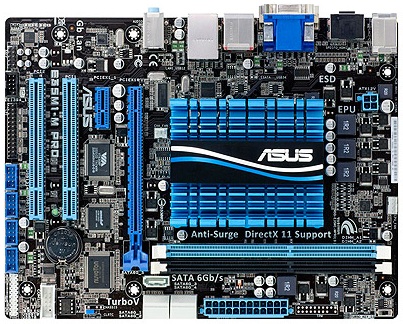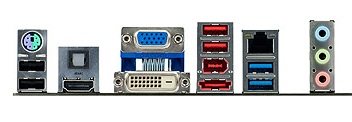ASUS E35M1-M Pro Review - Anyone For Fusion?
by Brendan van Varik on October 25, 2011 5:00 AM EST- Posted in
- Asus
- Motherboards
- Fusion
- E-350
The low powered AMD Fusion market is still an active one, and although the ASUS E35M1-M Pro has been available for a while, we have been asked to have a look. By definition, it is a low powered board with a 1.6 GHz dual core and a 500 MHz GPU clock with 80 stream processors. We clocked a basic system at around 32 W idle, with the APU cooled passively.
Overview
Whilst CPU or GPU intensive tasks are out of the question with a Fusion based system, Fusion boards do have their own advantages such as ultra low power consumption devices, which allow the APU to be passively cooled for a truly silent PC. The optional supplied micro-fan does not add much noise into the equation for low usage, but each end user may or may not want the noise in the background.
There are plenty of connectivity options available on the E35M1-M Pro. In total, there are six SATA 6 Gbps ports and twelve USB 2.0 ports available on this motherboard which should satisfy most requirements. Full HD playback is made possible by the built-in AMD HD 6310 GPU.
Overclocking is possible on the E35M1-M PRO, but as Ian has mentioned before in his round up of three Fusion E-350 motherboards, it is always down to how lucky you get with your silicon because the APU is already installed on the motherboard when you buy it. A respectable overclock of 12% was obtained which brings the final clock speed of the CPU up to 1.792 GHz.
Visual Inspection
The ASUS E35M1-M Pro makes use of a low power APU from AMD which is located under the heatsink in the middle of the board. ASUS are maintaining their current color scheme for their non-ROG branded boards and have gone with blue and black combination. The Hudson M1 FCH is located next to the APU and it provides support for six SATA 6 Gbps ports, five of which are internal and one is an eSATA port. Out of the five internal SATA 6 Gbps ports, four of them are angled and point away from the motherboard and one is not.

On the expansion side of things, we have a PCIe x16 slot which is electronically limited to x4, a PCIe x1 slot and two PCI slots. There are four USB 2.0 headers which will allow for up to eight extra USB 2.0 ports to be added into your system as well as a USB 3.0 header for an additional two USB 3.0 ports.

On the back of the board, we have a PS2 port (that can be used for either a keyboard or a mouse) and a total of four USB 2.0 ports. Two USB 3.0 ports are located under the gigabit LAN. Three different kinds of video connectivity are available and they consist of HDMI, DVI and D-SUB. There is also a S/PDIF optical output as well as a trio of audio jacks.

There are only two fan headers on this motherboard, one of which is for the CPU fan, which is located above the heatsink and just to the left of the DIMM slots. The second one is for a chassis fan and is located near the bottom left-hand side of the heatsink. An extra fan header would have been nice to see on a board this size, though is not absolutely necessary.










66 Comments
View All Comments
C300fans - Tuesday, October 25, 2011 - link
No, because 80sp is really really too weak for gaming.C300fans - Tuesday, October 25, 2011 - link
Even if a 800sp card, GDDR5 128bit is far enough. Can you tell the difference between HD 6790 and HD 6770? I could say, you will probably notice more on the price.silverblue - Tuesday, October 25, 2011 - link
The difference here is that the memory interface is shared by both the CPU and the GPU. It's not all about gaming, but the actual effective use of what's on offer.However, being a geek at heart, I wouldn't mind seeing what the turbo mode plus more memory bandwidth would do for light gaming as well as if the E-450 is only a tiny bit faster than the E-350 even with the extra bandwidth.
duploxxx - Tuesday, October 25, 2011 - link
its already been tested, between 5-10% more perf in general tasks with same consumption. Not bad at all for a small update. No graphics tested yethttp://asia.cnet.com/product/hp-pavilion-dm1-amd-f...
lestr - Tuesday, October 25, 2011 - link
Lap top/netbook review, does not equal desktop especially in a "review" that is a mere single page, maybe two, max. The 350 OC's to ~1.8 +/- and with memory upped to 1600 on a 6320 graphics core the results might be more interesting especially since folks are only now beginning to understand how to OC an APU properly. Drop the mult, crank the FSB for graphics and raise both to stable. That noted, it's certainly not about gaming but over all performance. 80SP's isn't much but more power/speed wouldn't hurt, now would it? 160 would be great. Maybe CPU can get to 2.0 or greater...
Also promised are reviews geared more toward HTPC use rather than gaming... that's like trying to take out an elefunk with a BB gun. Not much point in even going there.
Actually I am more interested in what is going to replace the M50 - 350/450 line - Jan? For now it looks like they're trying to deplete 350 inventories before bringing the 450 here. Even so, a lot of people would like to know.
thanks it's nice to see the interest.
rburnham - Tuesday, October 25, 2011 - link
This board seems too big for an HTPC and too underpowered for a gaming rig. Most people I know who use their computers for basic things (web browsing, spreadsheets) already have laptops and they prefer the portability over a desktop. I am not sure where this board fits in.mino - Wednesday, October 26, 2011 - link
This board is actuall;y great for HTPC for a very important reason - there are people who actually _need_ more than a single PCIe or PCI slot ...But otherwise, the real target would be cheap PC's for kids, secretaries and the like.
jrs77 - Tuesday, October 25, 2011 - link
I'm owning a Zotac IONITX A-E (used as NAS/webclient), an Asus AT3IONT-I Deluxe (used as HTPC) and a Lenovo Thinkpad x121e E350 (for travelling and whatever). All of them are basically the same when it comes to powerconsumption and they're all up to the task of playing Full HD-media.People will allways moan about the low-power CPUs of those systems, but if you don't do anything else then browsing the web and playback some media, there's nothing to complain about really. These systems even run older games perfectly fine, or they make for a good system to run a second client for EvE Online, etc.
Geofram - Tuesday, October 25, 2011 - link
In windows, will it stream Netflix without a problem?I used to have a Atom based HTPC, and HD content on Netflix wouldn't properly use the GPU acceleration, and hence, it wouldn't play smoothly. Something in the Silverlight acceleration didn't detect and use GPU for everything, and would fall back to CPU. So I'm more worried about that than I am about if it will play a Blu-ray, yet it's something I never see checked.
RayMort - Wednesday, October 26, 2011 - link
This is exactly what I need to know too. My 6 year old PC with an AMD 3500 dual core processor can't decode Netflix HD streaming for the same reasons. I want to upgrade, but I want to be sure it will do Neflix HD before I purchase.